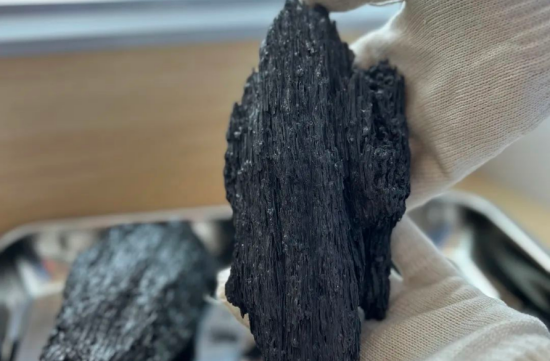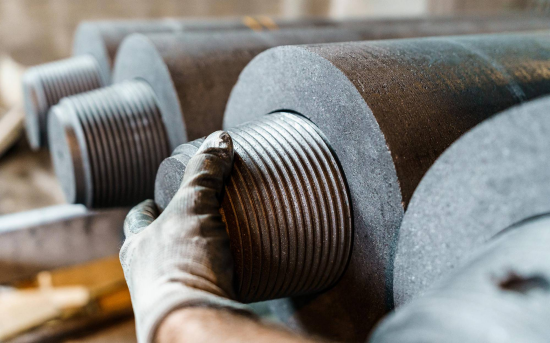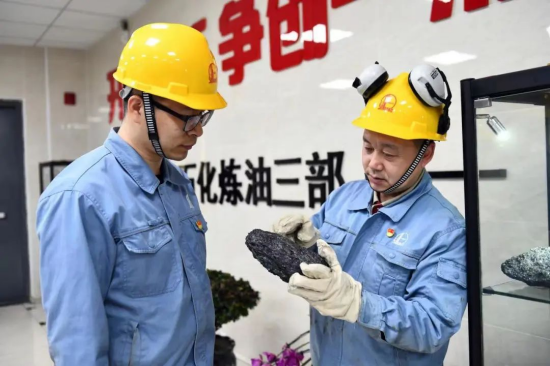【High-End Needle Coke:】The Path of Innovation in Ultra-High Power Graphite Electrodes

【High-End Needle Coke:】The Path of Innovation in Ultra-High Power Graphite Electrodes
01. What is Needle Coke?
Needle coke is a high-performance carbon material with a metallic luster, appearing silver-gray, with fibrous or elongated needle-like surface texture and a slippery feel. Internally, it contains a few large pores, generally oval-shaped, with excellent electrical and thermal conductivity, thermal shock resistance, and a low coefficient of thermal expansion. It has extremely broad applications in areas such as Graphite electrodes for steelmaking and aerospace, and has become a hot and key research focus in the domestic and international materials field in recent years.

02. What are the types of Needle Coke?
Needle coke can be divided into coal-based needle coke and petroleum-based needle coke depending on the raw material source. Coal-based needle coke is produced by high-temperature carbonization of coal tar, coal tar pitch, or flash-distilled oil. Petroleum-based needle coke is produced by high-temperature carbonization of ethylene tar, vacuum and thermal cracking residues, and catalytic cracking slurry oils. Due to its low sulfur, low ash, low metal content, and easy graphitization, it has become the main raw material for synthetic graphite. However, its production cost is relatively high, and it requires strict raw material quality.
03. What are the applications of Needle Coke in different fields?
The applications of needle coke mainly fall into three categories: high-power graphite electrodes, special carbon materials, and lithium-ion battery anode materials. High-power graphite electrodes made from needle coke can be used for electric arc furnace steelmaking, which has advantages such as lower pollution and energy consumption, and has been rapidly promoted in steel enterprises. High-power graphite electrodes made from needle coke have a low coefficient of thermal expansion, high electrical conductivity, and high mechanical strength, enabling efficient heating of molten metal in electric arc furnaces. As an anode material, needle coke, being soft carbon, has advantages such as easy graphitization and low cost. After high-temperature heat treatment, it can be prepared into synthetic graphite with good cycling stability and high specific capacity.
04. What are the properties of graphite electrodes? How are they classified?
Graphite electrodes are mainly used in electric arc furnaces, submerged arc furnaces, and resistance furnaces. Since electric arc furnace steelmaking is more environmentally friendly compared to blast furnace steelmaking, policies in various countries have increasingly favored the electric arc furnace industry in recent years. The continuous expansion of the electric arc furnace steelmaking scale has driven demand for graphite electrodes. In China, 70%–80% of total graphite electrode consumption is used for electric arc furnace steelmaking.
Graphite electrodes are classified according to their quality indicators into Regular Power (RP) graphite electrodes, High Power (HP) graphite electrodes, and Ultra-High Power (UHP) graphite electrodes. In terms of composition, the aggregate of regular power graphite electrodes consists entirely of petroleum coke; in HP electrodes, petroleum coke and needle coke account for 70% and 30%, respectively; in UHP electrodes, the aggregate consists of 100% needle coke.
UHP graphite electrodes are further divided into different grades according to diameter. Larger diameter UHP graphite electrodes have lower resistivity, lower thermal expansion coefficient, and better thermal shock resistance, which can significantly improve production efficiency in electric arc furnace steelmaking while reducing electricity consumption and electrode consumption, effectively promoting green and low-carbon development in the energy industry. However, as the diameter of UHP graphite electrodes increases, controlling their thermal expansion becomes more difficult, and the technical requirements for the conductivity, thermal conductivity, and strength of the aggregate needle coke become higher, in order to maintain uniform structure and thermal shock resistance during use.

05. What is the market situation for Ultra-High Power Graphite Electrodes?
According to relevant institutions, in 2024, China's graphite electrode production reached 637,700 tons. Among them, regular power Graphite electrodes accounted for 72,300 tons, high-power graphite electrodes 192,800 tons, and ultra-high power graphite electrodes 372,600 tons, representing an annual increase of 4.9% compared to 2023. It is forecasted that in 2025, the share of electric arc furnace steel in China will increase from 10% to 15%–20%. With the increase in electric arc furnace steel production, future total demand for ultra-high power graphite electrodes will further rise.
Enterprise Practices
01. Dalian Institute: Providing Technical Support for High-End Graphite Electrode Applications
In 2007, the Dalian Institute began independent research and development of needle coke. At that time, the quality of domestically produced petroleum-based needle coke was poor, and oil-based needle coke for UHP graphite electrodes with diameters of 600 mm and above relied on imports. The preparation technology for high-end petroleum-based needle coke became a "bottleneck" restricting the rapid development of China's electric arc furnace steelmaking and new energy industries.
In 2017, the Dalian Institute's needle coke R&D team developed the "THTD Catalytic Slurry Technology for Producing High-Quality Needle Coke," which possesses independent intellectual property rights. Under the guidance and resource support of the group company, the Dalian Institute, Jinling Petrochemical, and Guangzhou (Luoyang) Engineering units worked together, and by the end of 2020, a 150,000-ton/year high-end graphite industrial facility at Jinling Petrochemical was successfully established and has operated stably since, demonstrating the leading technology and reliable performance of Dalian Institute's needle coke technology.
Since 2022, the Dalian Institute's needle coke R&D team has actively promoted the quality improvement of Jinling Petrochemical's needle coke and laid out the downstream high-end product refinement. UHP graphite electrodes are an extremely important downstream application of needle coke. The Dalian Institute deeply explored the relationships among raw materials, processes, and products, as well as the correlations between process parameters and product quality, needle coke texture, and strength, constructing a core process parameter system. In 2024, UHP graphite electrodes with a 600 mm diameter prepared from 100% Jinling Petrochemical needle coke were successfully applied in four domestic steel plants, marking the successful high-end application of Chinese petroleum-based needle coke in graphite electrodes. In 2025, the first batch of 700 mm diameter UHP graphite electrodes manufactured from high-end Chinese petroleum-based needle coke was successfully delivered at Nantong Yangzi Carbon Company, marking a new milestone in the high-end application of Chinese petroleum-based needle coke in the graphite electrode field.

02. Jinling Petrochemical: Producing High-End Needle Coke Products to Meet Customer Demand
Jinling Petrochemical actively develops a "specialized, refined, and innovative" carbon materials industry chain, making needle coke a highlight product under its "Oil-to-Specialty" strategy. In collaboration with the Dalian Institute, the company established a high-end carbon materials R&D center and formed an integrated "R&D–Production–Sales" team. Specialists conduct daily product sampling, analyze quality data for each tower, hold targeted discussions based on the analysis, finely adjust parameters, and standardize operational requirements. This addresses nine major technical challenges, including unstable raw material properties, high coke powder content, poor needle coke texture, low hardness, and high moisture content. As a result, needle coke texture has become increasingly clear, and key indicators such as hardness and HGI (Hardgrove Grindability Index) can be customized according to downstream customer requirements.
In January 2021, China Petrochemical's first independently designed high-end graphite facility at Jinling Petrochemical successfully produced qualified products, achieving a breakthrough in continuous stable production of high-end needle coke. In 2022, the calcined needle coke joint venture project was completed and put into production in Lianyungang, Jiangsu. In 2024, 600 mm diameter UHP graphite electrodes produced from calcined needle coke were successfully trialed in steel plants, and key indicators for needle coke as an anode material matched those of imported high-end products. On May 14, this year, the first batch of 700 mm diameter UHP graphite electrodes produced from calcined needle coke at Jinling Petrochemical was successfully delivered at Nantong Yangzi Carbon Company.
03. Refining & Marketing Company: Production-Sales Coordination Supports Localization of Petrochemical High-End Materials
In 2024, the Refining & Marketing Company, through resource integration and optimization, promoted technical coordination and quality improvement, achieving cumulative sales of over 120,000 tons of needle coke products.
The company leveraged its advantages in industry chain coordination, integrating premium raw materials from upstream refineries such as Jinling Petrochemical, and applied a scientific supply-demand matching mechanism to provide high-end needle coke products to leading downstream enterprises. It also established a full-chain technical collaboration system covering "production–processing–application": on one hand, it fed back the process requirements of downstream graphite electrode manufacturers to the refineries to continuously optimize needle coke product indices; on the other hand, it collaborated with laboratories to address industry technical challenges such as reducing the CTE (coefficient of thermal expansion), significantly enhancing the stability of domestic needle coke quality.
Furthermore, the company actively built a three-dimensional sales network covering the steel industry, promoting the successful integration of Jinling Petrochemical needle coke products into leading enterprise supply chains. By collecting end-user feedback on critical indicators such as electrode breakage rate and tons of steel consumption, it established a virtuous cycle of market demand–product improvement–value enhancement. The company also pioneered a "capacity lock + joint R&D" cooperation model, establishing long-term strategic partnerships with upstream and downstream enterprises, providing a replicable model of production-sales coordination for the localization of high-end petrochemical materials. Currently, the company is exploring the integration of low-carbon refinery processes with downstream carbon footprint traceability systems, ensuring stable operation of the industry chain while providing innovative practice for the industry's green transformation.
Feel free to contact us anytime for more information about the Needle Coke market. Our team is dedicated to providing you with in-depth insights and customized assistance based on your needs. Whether you have questions about product specifications, market trends, or pricing, we are here to help.
No related results found








0 Replies